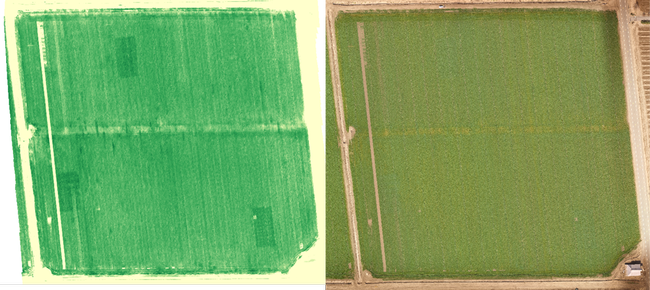As the fall planting season begins, we'd like to share recently developed case studies detailing N management actions and crop productivity outcomes in several small grain fields during the 2019-20 growing season. Growers from different parts of the state worked with UC Cooperative Extension to implement N-rich reference zones in their fields. The N-rich reference zone is a relatively small area within a field where extra N fertilizer is added at the beginning of the season. This extra fertilizer ensures that the reference zone is not N-limited between planting and the time when an in-season fertilizer decision is made. When a grower is determining whether and how much N fertilizer to add in-season, plant and soil measurements from both the reference zone and the broader field are compared to understand whether the broader field is sufficient in available N.
Case studies for four of the 2019-20 demonstration sites are available now at:
http://smallgrains.ucanr.edu/Nutrient_Management/N-rich_reference_zones/
These case studies describe the overall site conditions, the pre- and in-season soil and plant measurements, and the management actions taken related to N fertilizer. Each 2019-20 demonstration site utilized between one and four 90-ft by 180-ft N-rich reference zones, established in representative areas of the field at or near the time of planting. From the tillering stage of growth to the heading stage of growth, project leaders recorded measurements of canopy reflectance (i.e. NDVI/NDRE) and soil nitrate-N (via quick tests) in the top foot of soil both within N-rich reference zone(s) and in the broader field. Measurements were made prior to participating growers' in-season fertilizer management decisions.
Figure 1. Demonstration site in Solano County on 2/20/20 showing crop N deficiency signal. The three N-rich reference zones appear in the NDRE measurement (on the left) but are not visible to the naked eye (RGB image on the right).
When crop N deficiency was detected by real-time plant and soil measurements (e.g. Figure 1), N fertilizer recommendations were produced using a combination of the site-specific measurements and the expected crop N demand remaining for the field. When no deficiency was detected, monitoring continued until either deficiency was detected or the grower decided whether or not to apply N fertilizer in-season. Where possible, the alternative to the cooperating grower's management action (either applying N fertilizer when the grower applied none or excluding fertilizer when the grower decided to apply) was enacted. This allowed us to measure the effect of the management decision and the accuracy of the in-season N fertilizer recommendation. When the crop reached maturity, yields and grain N uptake were measured within the main field, the N-rich reference zones, and the alternative management zones (where applicable).
More case studies will be added to this site as they are completed. In addition, the UC Cooperative Extension team leading this project will be implementing N-rich reference zones on several grower fields in the 2020-21 season. So, please stay tuned to this blog for more announcements related to this demonstration project including upcoming extension events and the release of a web-based decision support tool for optimizing in-season N fertilizer management in California wheat.
This information is being produced by a statewide group of UC Cooperative Extension agronomists with the support of the CDFA-FREP and NRCS-CIG programs. Project contacts are: Mark Lundy, Taylor Nelsen, Nick Clark, Michelle Leinfelder-Miles, Konrad Mathesius, Sarah Light, Thomas Getts, and Giuliano Galdi.
